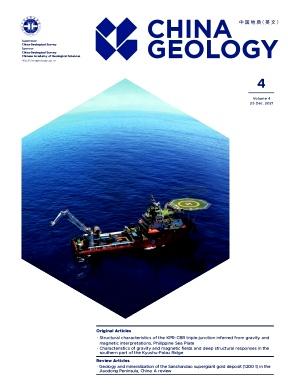In situ U-Pb dating and trace elements of magmatic rutile from Mujicun Cu-Mo deposit, North China Craton: Insights into porphyry mineralization
IF 4.7
3区 地球科学
Q1 GEOSCIENCES, MULTIDISCIPLINARY
引用次数: 0
Abstract
Porphyry Cu (Mo-Au) deposit is one of the most important types of copper deposit and usually formed under magmatic arc-related settings, whilst the Mujicun porphyry Cu-Mo deposit in North China Craton uncommonly generated within intra-continental settings. Although previous studies have focused on the age, origin and ore genesis of the Mujicun deposit, the ore-forming age, magma source and tectonic evolution remain controversial. Here, this study targeted rutile (TiO2) in the ore-hosting diorite porphyry from the Mujicun Cu-Mo deposit to conduct in situ U-Pb dating and trace element composition studies, with major views to determine the timing and magma evolution and to provide new insights into porphyry Cu-Mo metallogeny. Rutile trace element data show flat-like REE patterns characterized by relatively enrichment LREEs and depleted HREEs, which could be identified as magmatic rutile. Rutile U-Pb dating yields lower intercept ages of 139.3–138.4 Ma, interpreted as post magmatic cooling timing below about 500°C, which are consistent or slightly postdate with the published zircon U-Pb ages of diorite porphyry (144.1–141.7 Ma) and skarn (146.2 Ma; 139.9 Ma) as well as the molybdenite Re-Os ages of molybdenum ores (144.8–140.0 Ma). Given that the overlap between the closure temperature of rutile U-Pb system and ore-forming temperature of the Mujicun deposit, this study suggests that the ore-forming ages of the Mujicun deposit can be constrained at 139.3–138.4 Ma, with temporal links to the late large-scale granitic magmatism at 138–126 Ma in the Taihang Orogen. Based on the Mg and Al contents in rutile, the magma of ore-hosting diorite porphyry was suggested to be derived from crust-mantle mixing components. In conjunction with previous studies in Taihang Orogen, this study proposes that the far-field effect and the rollback of the subducting Paleo-Pacific slab triggered lithospheric extension, asthenosphere upwelling, crust-mantle interaction and thermo-mechanical erosion, which jointly facilitated the formation of dioritic magmas during the Early Cretaceous. Subsequently, the dioritic magmas carrying crust-mantle mixing metallic materials were emplaced and precipitated at shallow positions along NNE-trending ore-controlling faults, eventually resulting in the formation of the Mujicun Cu-Mo deposit within an intracontinental extensional setting.
华北克拉通穆吉村铜钼矿床岩浆金红石的原位 U-Pb 定年和痕量元素:斑岩成矿的启示
斑岩型铜(钼-金)矿床是最重要的铜矿床类型之一,通常形成于岩浆弧相关环境中,而华北克拉通地区的穆家村斑岩型铜-钼矿床则罕见地形成于大陆内部环境中。虽然以往的研究主要集中在穆吉村矿床的年龄、成因和矿石成因方面,但对其成矿时代、岩浆来源和构造演化仍存在争议。本研究以木吉村铜钼矿床含矿闪长岩斑岩中的金红石(TiO2)为研究对象,开展原位U-Pb定年和痕量元素组成研究,主要目的是确定成矿时代和岩浆演化,为斑岩铜钼成矿作用提供新的认识。金红石痕量元素数据显示了扁平状的 REE 模式,其特征是相对富集的 LREEs 和贫化的 HREEs,可确定为岩浆金红石。金红石 U-Pb 测定得出的截距年龄较低,为 139.3-138.4 Ma,解释为低于约 500°C 的岩浆后冷却时间,与已公布的闪长岩斑岩(144.1-141.7 Ma)和矽卡岩(146.2 Ma;139.9 Ma)的锆石 U-Pb 年龄以及钼矿石的钼矿 Re-Os 年龄(144.8-140.0 Ma)一致或略微晚于。考虑到金红石U-Pb系统的闭合温度与穆家村矿床成矿温度的重叠,本研究认为穆家村矿床的成矿年龄可推定为139.3-138.4Ma,与太行造山带晚期138-126Ma大规模花岗岩岩浆活动有时间上的联系。根据金红石中的镁和铝含量,认为含矿闪长岩斑岩的岩浆来源于地壳-地幔混合成分。结合以往在太行造山带的研究,本研究提出古太平洋板块俯冲的远场效应和滚回作用引发了岩石圈延伸、天体层上涌、地壳-地幔相互作用和热力-机械侵蚀,共同促进了早白垩世闪长岩岩浆的形成。随后,携带地壳-地幔混合金属物质的闪长岩岩浆在沿北东向控矿断层的浅部位置喷出并沉淀,最终在大陆内部延伸环境中形成了穆吉村铜钼矿床。
本文章由计算机程序翻译,如有差异,请以英文原文为准。
求助全文
约1分钟内获得全文
求助全文

 求助内容:
求助内容: 应助结果提醒方式:
应助结果提醒方式:


